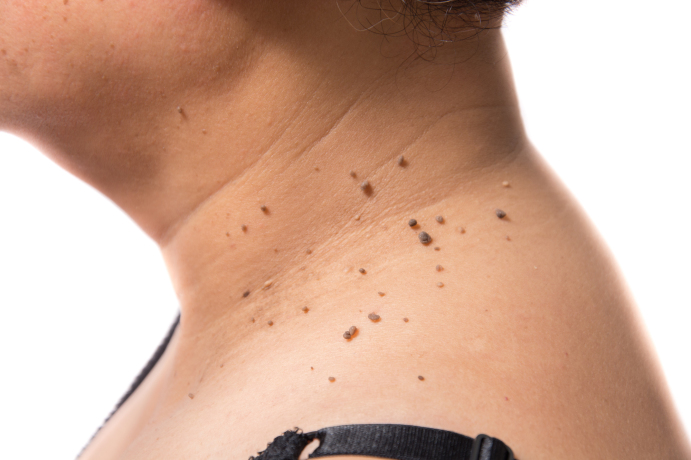
Wart ,Skintag and Mole Removal
Moles

Moles are one thing that is common to all humans. Every person has moles, maybe 1, maybe 40.
Moles are not a cause for concern unless they develop certain signs like: Itching / Increase in size / Change of colour.
In fact they are considered to be a beauty spot by many, especially on the face area. Some even consider this to be a sign of good luck and prosperity.
Moles can appear anywhere on the skin. They are of different shapes and sizes. Moles are usually brown to black in colour due to pigment melanin. Sometimes moles can be skin coloured. Moles are pre-determined at birth. They develop usually in the first 20 years of life and over the years due to sun exposure they can increase in numbers and darken in colour.
The life cycle of a mole is typically about 50 years. At the start, moles are mostly flat and look like a freckle or they can be black in colour. Over time they enlarge and some may develop hair. As the moles age they can become raised or they may not change at all.
In the recent years a lot has been spoken about cancer (Melanoma) and moles. What one must understand is that not all moles are cancerous. According to the American Academy Of Dermatology, if mole starts changing in size / colour / shape / especially if the border becomes ragged, you must consult your Doctor. The risk of Melanoma in Indian skin is much lower compared to other skin types as the skin has pigmentation which shields it to a certain degree from the effects of harmful UV Rays.
Mole Removal
Moles are removed for cosmetic as well as medical reasons. Do speak to our Surgeon if you are worried about a raised, itchy mole, which may have suddenly increased in size or changed colour.
Moles can be removed by two safe surgical methods: Simple excision (skin closure with sutures), or excision with cautery. Laser removal of moles is not the method of choice, because laser light does not penetrate deep enough. The treatment is done under local anesthesia, the healing time is about 1 week. Removed moles are usually sent to the laboratory for pathological analysis. If sutures are used to close the wound, the stitches are removed after 1 week.
Mole removal may lead to mild scarring, do discuss the possibility of scar formation with your dermatologist to make your decision.
If your moles are larger, irregularly coloured or very dark, alert your Doctor
These ABCDs describe suspicious spots/moles:
- Asymmetry: Oddly shaped
- Border: Irregular edges
- Colour: More than one colour present
- Diameter; More than a quarter inch in diameter or becoming larger.

What is the procedure for mole removal ?
The Surgeon will examine your mole and then suggest the best method to remove it.
Usually, a local anesthetic is injected with a fine needle, and then the mole is removed either surgically or with a laser. There may be a residual scar for the next few days, which usually resolves without any further treatment.
Large moles (> 1 cm) need sutures after excision, and that may leave a linear scar. The scar is usually more cosmetically acceptable than the Mole, and can be treated with Fractional laser.Other treatment for lathe Mile or Naevus are Serial excision and primary suturing, primary excision with FTG, Primary excision with local Flap cover
Wart Removal
Warts are a skin infection by human papilloma virus. They are recurrent, and are commonly seen on the face, hands, and feet. Warts need to be treated to prevent spread to other areas and to others.
Warts can be treated with a simple, effective, painless radio frequency treatment and Co2 laser ablation. This is done under topical anesthesia to reduce discomfort.




